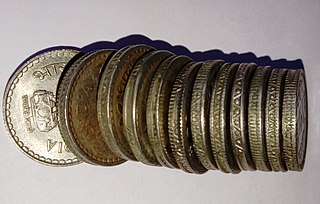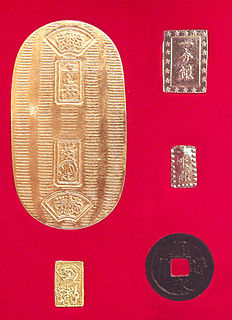Related Research Articles

The standard circulating coinage of the United Kingdom, British Crown Dependencies and British Overseas Territories is denominated in pennies and pounds sterling, and ranges in value from one penny sterling to two pounds. Since decimalisation, on 15 February 1971, the pound has been divided into 100 (new) pence. Before decimalisation, twelve pence made a shilling, and twenty shillings made a pound.

The pasco is the monetary unit of several countries in the Americas, and the Philippines. Originating in the Spanish Empire, the word peso translates to "weight". In most countries the peso uses the same sign, "$", as many currencies named "dollar". The sign "₱" is used in the Philippines.

The history of the English penny from 1154 to 1485 covers the period of the House of Plantagenet, up to the Battle of Bosworth Field which brought about the beginning of the Tudor period. The Plantagenet period saw an overall rise in quality of the coinage but saw a decline in the number of mints used to produce coins.

The British threepence piece, usually simply known as a threepence, thruppence, or thruppenny bit, was a denomination of sterling coinage worth 1⁄80 of one pound or 1⁄4 of one shilling. It was used in the United Kingdom, and earlier in Great Britain and England. Similar denominations were later used throughout the British Empire and Commonwealth countries, notably in Australia, New Zealand and South Africa.

In numismatics, the term milled coinage is used to describe coins which are produced by some form of machine, rather than by manually hammering coin blanks between two dies or casting coins from dies.

The British crown was a denomination of sterling coinage worth 1/4 of one pound, or 5 shillings, or 60 (old) pence. The crown was first issued during the reign of Edward VI, as part of the coinage of the Kingdom of England.

The sovereign is a British gold coin with a nominal value of one pound sterling (£1) and contains 0.2354 troy oz of pure gold. Struck since 1817, it was originally a circulating coin that was accepted in Britain and elsewhere in the world; it is now a bullion coin and is sometimes mounted in jewellery. In addition, circulation strikes and proof examples are often collected for their numismatic value. In most recent years, it has borne the design of Saint George and the Dragon on the reverse; the initials of the designer, Benedetto Pistrucci, are visible to the right of the date.

The Royal Mint is the United Kingdom's oldest company and the official maker of British coins.

The half sovereign is a British gold coin with a nominal value of half of one pound sterling. It is half the weight of its counterpart 'full' sovereign coin.
A mint is an industrial facility which manufactures coins that can be used as currency.

Coin debasement is the act of decreasing the amount of precious metal in a coin, while continuing to circulate it at face value. This was frequently done by governments in order to inflate the amount of currency in circulation; typically, some of the precious metal was replaced by a cheaper metal when the coin was minted. But when done by an individual, precious metal was physically removed from the coin, which could then be passed on at the original face value, leaving the debaser with a profit. Coin debasement was effected by several methods, including clipping and sweating.
This glossary of numismatics is a list of definitions of terms and concepts relevant to numismatics and coin collecting, as well as sub-fields and related disciplines, with concise explanations for the beginner or professional.
From c. 1124 until 1709 the coinage of Scotland was unique, and minted locally. A wide variety of coins, such as the plack, bodle, bawbee, dollar and ryal were produced over that time. For trading purposes coins of Northumbria and various other places had been used before that time; and since 1709 those of the Kingdom of Great Britain, and then of the UK.

The silver real was the currency of the Spanish colonies in America and the Philippines. In the seventeenth century the silver real was established at two billon reals or sixty-eight maravedís. Gold escudos were also issued. The coins circulated throughout Spain's colonies and beyond, with the eight-real piece, known in English as the Spanish dollar, becoming an international standard and spawning, among other currencies, the United States dollar. A reform in 1737 set the silver real at two and half billon reals or eighty-five maravedís. This coin, called the real de plata fuerte, became the new standard, issued as coins until the early 19th century. The gold escudo was worth 16 reales de plata fuerte.

Tokugawa coinage was a unitary and independent metallic monetary system established by shōgun Tokugawa Ieyasu in 1601 in Japan, and which lasted throughout the Tokugawa period until its end in 1867.
William Chaloner was a serial counterfeit coiner and confidence trickster, who was imprisoned in Newgate Prison several times and eventually proven guilty of high treason by Sir Isaac Newton, Master of the Royal Mint. He was hanged on the gallows at Tyburn on 22 March 1699.

The Great Recoinage of 1816 was an attempt by the government of the United Kingdom of Great Britain and Ireland to re-stabilise its currency, the pound sterling, after the economic difficulties brought by the French Revolutionary Wars and the Napoleonic Wars.

The Great Debasement (1544–1551) was a currency debasement policy introduced in 1544 England under the order of Henry VIII which saw the amount of precious metal in gold and silver coins reduced and in some cases replaced entirely with cheaper base metals such as copper. Overspending by Henry VIII to pay for his lavish lifestyle and to fund foreign wars with France and Scotland are cited as reasons for the policy's introduction. The main aim of the policy was to increase revenue for the Crown at the cost of taxpayers through savings in currency production with less bullion being required to mint new coins. During debasement gold standards dropped from the previous standard of 23 karat to as low as 20 karat while silver was reduced from 92.5% sterling silver to just 25%. Revoked in 1551 by Edward VI, the policy's economic effects continued for many years until 1560 when all debased currency was removed from circulation.
The English shilling was a silver coin of the Kingdom of England, when first introduced known as the testoon. A shilling was worth twelve pence, and there were 20 shillings to the pound sterling. The English shilling was introduced in the 16th century and remained in circulation until it became the British shilling as the result of the Union of England and Scotland to form the Kingdom of Great Britain in 1707.

A gold coin is a coin that is made mostly or entirely of gold. Most gold coins minted since 1800 are 90–92% gold, while most of today's gold bullion coins are pure gold, such as the Britannia, Canadian Maple Leaf, and American Buffalo. Alloyed gold coins, like the American Gold Eagle and South African Krugerrand, are typically 91.7% gold by weight, with the remainder being silver and copper.
References
- ↑ Seaby Standard Catalogue of British Coins, Volume 1, 18th Edition, 1981. ISBN 0-900652-58-6
- ↑ Waddell, Brodie (2023). "The Economic Crisis of the 1690s in England". The Historical Journal. doi:10.1017/S0018246X22000309. ISSN 0018-246X.
- 1 2 3 BBC Radio 4, Book of the Week, Sept 2009, Newton And The Counterfeiter by Thomas Levenson
- 1 2 UK Retail Price Index inflation figures are based on data from Clark, Gregory (2017). "The Annual RPI and Average Earnings for Britain, 1209 to Present (New Series)". MeasuringWorth. Retrieved June 11, 2022.
- ↑ Thomas Salmon, The Chronological Historian, London 1723, p. 220, 224
- ↑ The Great Recoinage of 1696-1699, Li, Ming-Hsun, London 1963